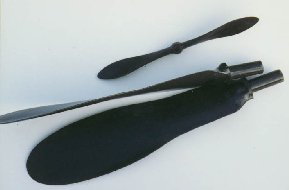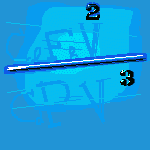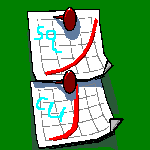

Free Enterprises' Product specification (and calculation) sheet
intro
boat, propeller, and hydrofoil math
ergonometer (human power output) data
carbon fiber properties compared to other materials
| This image is of two extremes offered by Free Enterprises. The smaller one is of the carbon fiber GLM almost hubless hi performance hydrofoil prop; 16 in dia, 30 pitch. The big ones are of the carbon fiber ODT changeable pitch hi thrust submarine prop; 5 foot dia, 8 foot optimum/adjustable pitch. |  |
| The "orbital" hand\foot powered hydrofoil employs a GLM prop, an 80 in. span hydrofoil drive unit in the rear, a 20 in. "T" shuttstrut for attitude control, custom carbon fiber hand cranks, some custom machine work, and a custom carbon fiber sandwitch frame. |  |
H R - 2: two blade 12 in pitch, 12 in dia, lift coef. .5, optimum is .2 HP @ 6 mph and 540+rpm. recommended for extremely light catamarans, etc. and recreational hydrofoils with light duty high reving low torque drive systems.
H R - 3: Three blade 12 in dia. 12 in pitch lift coef. .5, optimum is .3 hp @ 6 mph and 540 rpm. Recommended for light low resistance displacement boats and recreational hydrofoils, and supplying a little more power than H R 2.
H R - 5: Five blade 12 in dia. 12 in pitch, lift coef. .5 , optimum is .5 hp @ 5 mph and 530 rpm. This model can deliver a lot of thrust within it's small diameter. Ideal for a heavy payload i.e. kinetic sculpture.
JME - 2: 2 blade 17" dia. 24" pitch .5 hp @ 5.5 mph, .7 lift coef. good for 1 & 2 seat low resistance displacement boats.
TSA - 2 : two blade 18" dia. 18" pitch apx. 5 hp @ 4 mph; .7 lift coef good for single seat drive unit with large payloads; for multi seat drives, will work with larger power, less speed.
LJMQ - 3: three blade LEFT HAND 16" dia. 29" pitch 5 deg tip, 12 deg hub rake; MADE TO ROTATE OPPOSITE JME - 2 FOR A COUNTER ROTATING SYSTEM . .5 HP @ 5.5 mph, good for high thrust high power in kinetic sculptures, submarines, multi person boats, high displacement boats, etc.
GLM-2: (see picture) 16in dia., 30 in . pitch, .7 lift coef. .75 HP @ 12.5 mph, custom sections. High performance "spoon prop" with very minimal hub. This propeller is designed for hydrofoils, but will also work for high performance displacement boats.
UWF-2: 27 in dia; 23 in pitch Cl=.72; .18 HP @ 3.45 mi/hr, NACA 6700 sections with tapered thickness, High thrust/ low velocity (like a submarine), but has tested very well on a four seat catamaran.
JSE-2: very similar to JME, except Cl =.4 and req. less resistance.
JSE-5: Five blade 17 in dia., 24 in pitch, Cl= .4 1.2 HP @ 7 mi/hr
ODT- single blade piece (comes in set of two or more; see picture)
propeller sizing
When sizing up a propeller for your boat , the two absolute things you need to know are:
1. chosen optimal VELOCITY of your boat
2. force of RESISTANCE at that velocity
Other factors nice to know:
3. Power can be substituted for force but velocity must still be established.
4.clearance from hub to hull (propeller DIAMETER).
5. shaft diameter or BORE (note that free enterprises can bore a hub to any size within the hub constraints!)
INTERNAL PUSH/PULL/FLAP ATTITUDE CONTROL STRUT: all carbon fiber has hinge and flap foil, internal push/pull rod to control attitude.
ATTITUDE CONTROL "SHUTTSTRUT": one piece float-arm and foil self-adjusting attitude control rudder. Same as kind used in Hydroped, Flying Fish and Decavitator.
HYDROFOIL DRIVE UNIT: 2 ft2 foil surface; naca 4415 foil sections rated for apx 400 lbs.; weighs 12 lbs (unpacked). Ask about a good deal on an accompanying GLM propeller.
(coming soon) RECREATIONAL HEAVY DUTY HYDROFOIL DRIVE UNIT: Simpler/fewer moving parts, more surface area, adjustable foil angle.
boat, propeller & hydrofoil
math © Jake Free
torque formulas
In propellers, the main formula involving force and propeller shaft torque is:
F = 2 pi T / p, where F is the force of drag on the hull (and therefore the thrust); pi is 3.141592...; T is the torque on the propellershaft; p is the propeller pitch.
The main formula involving power is:
P = 2 pi T V / (550) p , where variables above are the same, along with P being the power, and V being velocity;
NOTE: These units are in English: power >> horsepower; pitch >> feet; torque>> foot lbs; velocity >> feet per second; force >> lbs.
CAUTION: Do'nt forget to change the (550) if calculating in metric, and don't forget to express pitch in feet, not inches!
Source, Jake's notes: 4-4-85
 |
 |
 |
cube square law for hydrofoils;
It goes like this: " weight increases as the cube of the linear dimensions, and lift as the square
The best example this writer can come up with is the absolutely lousy aerodynamics that a bug can get away with as compared to, say a condor.
It can be assured that with hydrofoils, the dynamics have to be tight and the boat has to be LIGHT
The moral. . .make your hydrofoil as light as you can, and when you test it, be sure to empty the change out of your pockets!!!
more interesting facts about human powered hydrofoils:
The following may help explain how the lift/drag formula works.
There is a most amazing coincidence about human powered hydrofoils. If you compare them to model airplanes, they are similar in so many ways. The only difference is the velocity, and the density relationships.Your typical RC model airplane and a typical (?) HP hydrofoil have the same general proportions, the same wingspan, the same horsepower, the same propeller diameter, control surface size, pitch (HP hydrofoil props are three to five times larger in pitch, but all things considered, that's still pretty close!, AND HP hydrofoils' velocity is three to five-or more-times slower).
Water is some 750 times more dense than air, and therein lies the difference. Since water is that much more dense, than the weight supported by HP hydrofoil is about the same amount greater. Also, the structure of the hydrofoil must be that much stronger. . .But aside from that, the other stuff is pretty much the same.
. . .fascinating. . .
 (top)
.
(top)
.
ergonometer (human power output) data
Power output for humans: 50 percentile male; 80 percentile athlete:
"all day"@ .25 Horsepower
"hour" @ .33 HP
"20 minutes" @ .5 HP (same as riding a tenspeed @ 23 mph)
"3 minutes" @ .75 HP (same as riding a tenspeed @ 27 mph)
"10 seconds" @ 1.2 HP (same as riding a tenspeed @ over 30 mph)
-- You should use 1.5 pedals per second as a comfortable cadence
Source: data: summer '86 ergometric expariment ©Jake Free, Mark Tucker, Amy Black
carbon fiber properties compared to other materials edited by Jake Free
2--8--90 PROPERTY COMPARISONS; CARBON FIBER AND VARIOUS MATERIALS. Virgin carbon fiber properties will be immediately followed by an estimate of a 25/75 matrix of a compression laminate in parentheses ( ).
|
|
|||||||||||||||||||||||||||
|
|
|||||||||||||||||||||||||||
|
1. References:Bruce Kelly "Building in Fiberglass". Yacht Racing/ cruising,p. 71-73: July/ AUG, 1982
2. "Modern Plastics Encyclopedia 1988", p. 184. NY: McGraw Hill
3. Clifford Hampel "Rare Metals Handbook" p. 696, NY: Robert Krieger (1971)
4. A.D. Meriman, "A Dictionary of Metalurgy" p. 191, NY: Pittman Publishing, (1958)
5. Free Enterprises, and suppliers